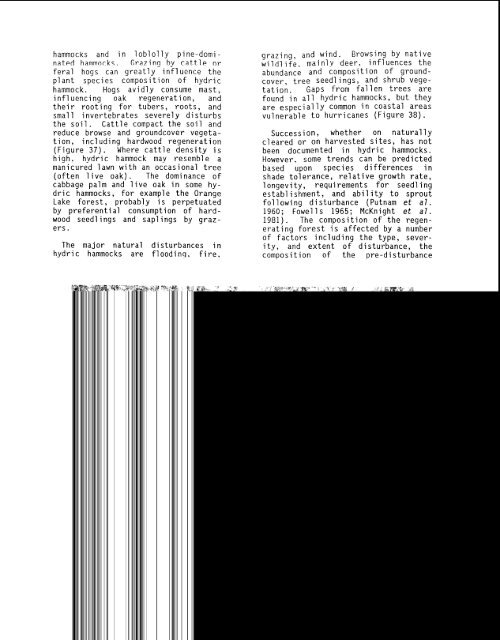The Ecology of Hydric Hammocks - USGS National Wetlands ...
The Ecology of Hydric Hammocks - USGS National Wetlands ...
The Ecology of Hydric Hammocks - USGS National Wetlands ...
Create successful ePaper yourself
Turn your PDF publications into a flip-book with our unique Google optimized e-Paper software.
hammocks and in loblolly pine-domi -natd hammnrkq. Cr27i179 hy cattle nrferal hogs can greatly influence theplant species composition <strong>of</strong> hydrichammock. Hogs avidly consume mast,infl uenci ng oak regenerati on, andtheir rooting for tubers, roots, andsmall invertebrates severely disturbsthe soil. Cattle compact the soil andreduce browse and groundcover vegetation,including hardwood regeneration(Figure 37). Where cattle density ishigh. hydric hammock may resemble amanicured lawn with an occasional tree(<strong>of</strong>ten live oak). <strong>The</strong> dominance <strong>of</strong>cabbage palm and live oak in some hydrichammocks, for example the OrangeLake forest, probably is perpetuatedby preferential consumption <strong>of</strong> hardwoodseedlings and saplings by grazers.<strong>The</strong> major natural disturbances inhydric hammocks are floodins. fire,grazing, and wind. Browsing by nativewild3 ife. main1 v deer, influences theabundance and composition <strong>of</strong> groundcover,tree seedl ings, and shrub vegetation.Gaps from fallen trees arefound in all hydric hammocks, but theyare especial ly common in coastal areasvulnerable to hurricanes (Figure 38).Succession, whether on naturallycleared or on harvested sites, has notbeen documented in hydri c hammocks.However. some trends can be predictedbased upon species differences inshade to1 erance, re1 ati ve growth rate,longevity, requirements for seed1 ingestabl ishment, and ability to sproutfollowing disturbance (Putnam et a?.1960; Fowells 1965; McKnight et a7.1981). <strong>The</strong> composition <strong>of</strong> the regeneratingforest is affected by a number<strong>of</strong> factors including the type, severity,and extent <strong>of</strong> disturbance, thecomposition <strong>of</strong> the pre-disturbanceFigure 37. A grazing exclosure in Gulf Hammock demonstrates the effects <strong>of</strong> cattle and deer on theground cover <strong>of</strong> hydric hammock. Wood fern is a predominant species both inside and outside theexclosure, but its height is greatly reduced by grazers.

















